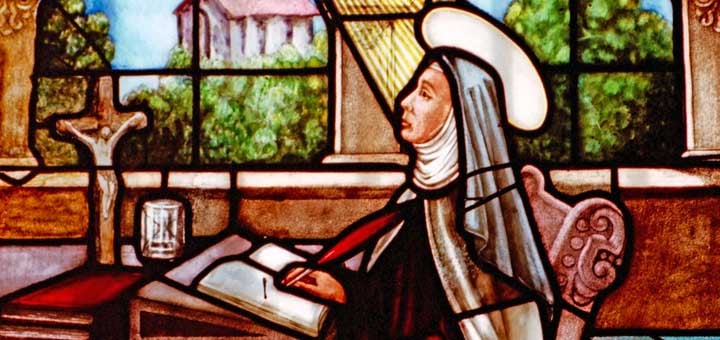Mystic, foundress, reformer, author, and spiritual guide, Teresa of Avila was an amazing woman and a great saint.
She was intelligent and strong-willed, yet tender and loving. Charming, witty, a great conversationalist, and at times a bit of a flirt, she also could be single-minded, determined, and tough as nails when needed.
Teresa had that rare combination of beauty, talent, energy, and savvy that makes a great leader…and she used it to the full.
Traversing across thousands of miles of Spanish countryside by horse, cart, and wagon, she established 17 convents and friaries—all in the last 20 years of her life. Five hundred years later, the Discalced (shoeless) Carmelite order she reformed/formed is still active with 12,000 nuns, 4,000 friars, and 40,000 lay members.
As well, the books she wrote on prayer and the spiritual life are considered essential even today for anyone wishing to grow in union with God.
In short, St. Teresa was awesome!
Early Life
Born in 1515 to a noble family, though a bit down on their luck financially, Teresa was torn between worlds as a youth. She loved reading tales of romance and chivalry, but also pretended to be a nun, made habits out of old clothes, and acted out scenes from the Gospels.
She set out on a quest with her brother at 7 years old to find martyrdom at the hands of Moors, only to be spotted by a relative outside the city walls and sent home.
She joined the Carmelites at 20, but religious life was different than what we might think of today. At the Convent of the Incarnation where she lived, wealthy girls kept their titles, garnered large, comfortable quarters (Teresa had her own kitchen), and sometimes even had servants.
Often the nuns spend time away with family and friends, and entertained patrons in the convent parlors. Teresa loved these gatherings. She was the life of the party. Needless to say, all these extra-curricular activities cut into prayer time. Growth in the spiritual life was a secondary concern at Teresa’s convent…and most liked it that way.
Called to Reform
But the Lord called Teresa to something more. As her relationship with God grew, the laxity of Carmelite life left her discontent. With a few friends, she began a different kind of convent dedicated to prayer. They engaged in a simple hermit lifestyle with one goal—deeper friendship and union with God.
Her movement caught on and soon Teresa was asked to establish more Carmelite convents in the stricter, reformed style. She also received permission to start houses for men and, with St. John of the Cross, founded the first Discalced Carmelite friaries.
She died in 1582 while on one of her journeys. Forty years later she was canonized. In 1970, she became the first woman Doctor of the Church, along with Catherine of Siena.
Teresa's Interior Castle
Teresa’s best known work is The Interior Castle. She uses the image of a crystal castle with seven successive chambers or mansions to describe the stages of the spiritual life. Each mansion is a stage. In the center is Jesus. As you move through the mansions, you move toward the interior and union with him.
The book describes prayer in the different mansions and how it changes as you progress. At first, the most important kind of prayer is mental prayer or meditation. This requires serious effort on your part—thinking, reflecting, making applications, speaking to God, and then listening to his inspirations. The goal is to rid yourself of sins, grow in virtue, and love God more. God helps, but the work is on you.
If you are steadfast, God begins to take over. Prayer becomes less of you working and more of God working in you. He infuses prayer into your soul, giving you a “quiet, deep and peaceful happiness in the will,” Teresa says. This is the Prayer of Quiet.
As you progress, this infused prayer deepens and strengthens. Your will unites to God’s will. He absorbs you in a peaceful, satisfying infusion of love, the Prayer of Union.
By the seventh mansion, the soul is completely united with God. His will is your will. This is where saints are made: the Transforming Union. Intimacy with God is so deep here, Teresa calls it Spiritual Marriage.
In this last stage, saints become productive, effective instruments of God. They only want what he wants and their work is an extension of his will. So, God clears obstacles, paves the way, and things happen. Teresa did the majority of her work reforming the Carmelites and founding new convents while in this stage.
Prayer and the Making of Saints
Teresa’s experience and insight illuminate the true nature of prayer. Prayer is foremost about love. At first, it’s about changing yourself and developing a love for God. But as you ascend to the higher stages, it’s about receiving the love God wants to give you and allowing him to change you. God pours his love into your heart and that love transforms you from the inside out.
It makes sense if you think about it. The spiritual life is all a grace. You can't work your way to heaven. No amount of penance and purification will perfect you enough to be a saint. God has to do it in you. And that happens in the forge of the Transforming Union where God welds the soul to him.
Yes, Teresa of Avila was awesome…and still is! She lives on through her writing and spiritual tradition. 500 years old this year, her spirituality is fresh and alive and relevant. It lives renewed whenever anyone seeks a deeper prayer and union with God.
Do you find prayer a chore? Do you pray out of obligations or duty but get nothing from it? Try praying like you're cultivating a relationship with a friend...who may end up becoming something more.
Copyright 2015 Marc Cardaronella
Image: "Spain 76" by Dennis Jarvis (2009) via Flickr, CC 2.0
About the Author

Marc Cardaronella
Marc Cardaronella is the author of Keep Your Kids Catholic: Sharing Your Faith and Making It Stick from Ave Maria Press. Marc directs catechist and discipleship leader formation for the Diocese of Kansas City-St. Joseph, MO. He is married, has two teen boys, and writes about Catholic spirituality and how to share the Faith on his personal blog.



.png?width=1806&height=731&name=CatholicMom_hcfm_logo1_pos_871c_2728c%20(002).png)
Comments